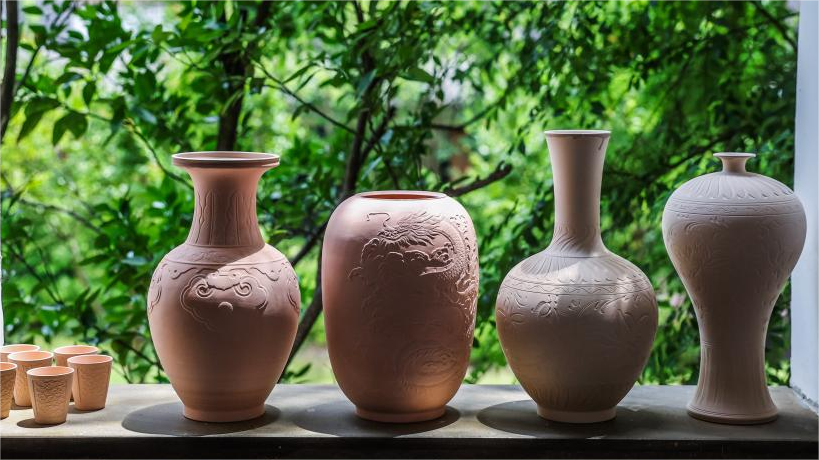"Seeking and sharing wisdom": How a sculptor's works bring Chinese culture to the world
BEIJING, June 11 (Xinhua) -- Two majestic bronze sculptures of the great Chinese philosophers Confucius and Lao Tzu have recently been unveiled at Batlle Park in Montevideo, capital of Uruguay.
The artwork, titled "In Search of Wisdom -- Confucius Asking Lao Tzu about the Tao," consists of two figures standing at 7.8 meters tall and weighing 6.6 tons. It is a masterpiece of renowned sculptor Wu Weishan, who is also the curator of the National Art Museum of China.
"The sculptures stand as the tallest and farthest-traveled pieces among my works abroad," Wu said, emphasizing that the great sages of Chinese history transcend national boundaries, belonging not only to China but also to the world. "I want to let the world see more Chinese figures standing tall."
SEEKING AND SHARING WISDOM
The base of the artwork is adorned with inscriptions narrating the story behind the sculptures in both Chinese and Spanish: the philosopher Confucius asking another philosopher, Lao Tzu, about the Tao, a central idea in Taoism. Both lived more than two millennia ago.
The concept of Tao represents the fundamental nature and source of the universe, encompassing the underlying order and flow of all life.
During her visit to China in 2018, Lucia Topolansky, then vice president of Uruguay, made a special trip to Wu's studio. Immediately captivated by the artwork, she "extended an invitation" to the two Chinese eminent thinkers and philosophers to Uruguay in the hope of future generations being able to hear their dialogue.
Six years later, the two sculptures crossed the ocean and were placed among the trees in Batlle Park. When the sculptures were slowly lowered from a giant crane and finally touched the ground, Wu, who was watching the video remotely, was "extremely excited."
"These two sages have left their homeland, but they are not alone. They have 'kindred spirits' all over the world who love to hear them speak about benevolence, the Tao, and virtue," he said.
For over 2,000 years, Confucianism, centered on the teachings of Confucius, has spread to East Asia, Europe, and the Americas, leaving its mark the world over.
As early as the 16th century, Italian missionary Matteo Ricci translated Confucian classics, the "Four Books," into Latin, and brought them to Europe, sparking a wave of "Confucianism fever" and providing important intellectual support for the subsequent European Enlightenment.
"Tao Te Ching" by Lao Tzu is one of the most widely translated Chinese classics globally. According to American sinologist Misha Tadd, the book has been translated into 97 languages, with a total of 2,052 versions.
"The artwork tells the story of Confucius and Lao Tzu seeking and sharing wisdom. In reality, this is also the relationship between China and the world," Wu said.
First, China "seeks wisdom" from the world, the Chinese sculptor explained, noting that he aspired to demonstrate Chinese people's modesty and curiousness through his works.
"At the same time, I hope to make Chinese culture known to the rest of the world, helping it go out and integrate with other cultures. This process itself is also 'sharing wisdom'," said Wu.
Montevideo Mayor Mauricio Zunino said this work showcases the profound heritage of Chinese culture, embodying great wisdom and values.
The two Chinese sages from 2,500 years ago have become a new landscape in the 300-year-old Montevideo, bringing new cultural experiences to residents and tourists, he said. Moreover, it will further strengthen cultural exchanges between China and Uruguay, making the two countries intimate friends, he added.
CHINESE FIGURES STANDING TALL
Back in the 1990s, Wu, touring museums and antique markets in Western countries, noticed that the depictions of Chinese people in artworks were outdated, rigid, and even deliberately caricatured. These stereotypes "deeply saddened" him.
Since then, he has been determined to create sculptures depicting outstanding figures from Chinese history, and to bring these images to a global audience, showing the indomitable spirit and enterprising energy of the Chinese people.
To date, Wu has created over 600 sculptures of prominent figures in the fields of art, culture and science, more than 60 of them having been installed in over 30 countries and regions worldwide.
His works include ancient sages like Confucius, Lao Tzu, and Li Bai, as well as pioneers of cultural exchange such as Master Jianzhen and Zen Master Yinyuan Longqi.
"There should be dignified Chinese figures standing tall in the world," said Wu. "These sculptures do not speak, but their images serve as a silent language and are symbols of Chinese culture."
In July 2022, Wu's bronze statue of Master Jianzhen, also known as Ganjin in Japan, was unveiled at the Shinobazu Pond in Ueno Park, Tokyo. The sculpture depicts the monk who made six journeys to Japan to spread Buddhist teachings and Tang Dynasty culture, and lost his sight during stormy voyages.
The sculpture powerfully conveys the spirit of the blind monk, whose "heart sees clearly," Japanese seal carver Myohseki Shimura told Xinhua. "It deeply moves everyone who sees it."
Wu voiced confidence that works depicting the inner virtues of Chinese culture will be appreciated by all humanity. "Seeing more of my dignified Chinese figures overseas fills me with joy. It's not only a recognition of my work but also a testament to China's greatness."
DIFFERENT FACES, ONE HUMANITY
Nikos Kazantzakis, a giant of modern Greek literature who had visited China twice, commented that "Confucius and Socrates were two masks that covered the same face of human logic."
More than 2,000 years ago, the golden age of ancient Greece witnessed the emergence of many philosophical and literary giants. Among them was Socrates, who often came to the Ancient Agora of Athens, then a marketplace at the foot of the Acropolis, debating with thinkers, writers and politicians and communicating his ideas.
Roughly at the same time in China, far on the other side of the Eurasian continent, the period of ideological flourishing among the Hundred Schools of Thought, most notably Confucianism, was unfolding.
Today, at the Agora, Wu's sculpture "Divine Encounter -- Dialogue between Confucius and Socrates" has brought Confucius to Socrates' hometown.
The statues of the two great philosophers from the East and the West stand side by side as if they have crossed the boundaries of geography and time and are having a moment of exchange of ideas.
"Their spiritual worlds are connected. One emphasized 'the world of great harmony' and advocated 'within the four seas all men are brothers,' while the other discussed the ideal form of state and sought to establish a just and orderly society," Wu said.
"The 'dialogue' between them symbolizes a new stage and a new model of cultural exchanges and integration between the East and the West," he said.
Apart from "dialogue" between philosophers from different cultures, there is also "dialogue" between artists.
Another sculpture work by Wu, featuring Leonardo Da Vinci having a dialogue with Chinese painter Qi Baishi, is permanently exhibited in Vinci, a town in the Italian province of Florence widely known as the Renaissance master's hometown.
"These two bronze sculptures are very heavy, but I was afraid that they might move at any moment," Italian artist Andrea Nicita shared his thoughts after seeing the sculpture.
He imagined a scene of the two great artists conversing: "Leonardo points to the sky, saying to Qi, 'Look, we are here on earth to unite everyone to make people live better.' And Qi, leaning on his cane, replies, 'Yes, dear Leonardo.'"
Nicita opined that it is important that "the world gets closer and people get closer to each other," and in this regard, art, as a "language" for dialogue among civilizations, enables people from diverse cultural backgrounds across the world to influence and integrate with each other.
This echoes Wu's opinions. "Mutual understanding among humans comes from the dialogue of ideas," he said, adding that through dialogue among human civilizations, different countries and ethnic groups can communicate their thoughts, blend their emotions, enhance understanding, and seek common development.
Photos
Related Stories
Copyright © 2024 People's Daily Online. All Rights Reserved.









